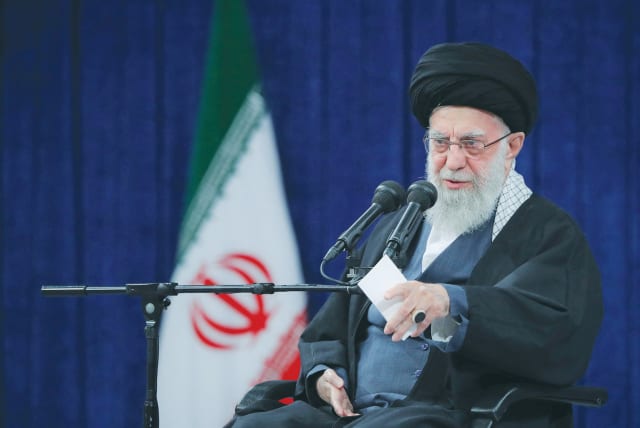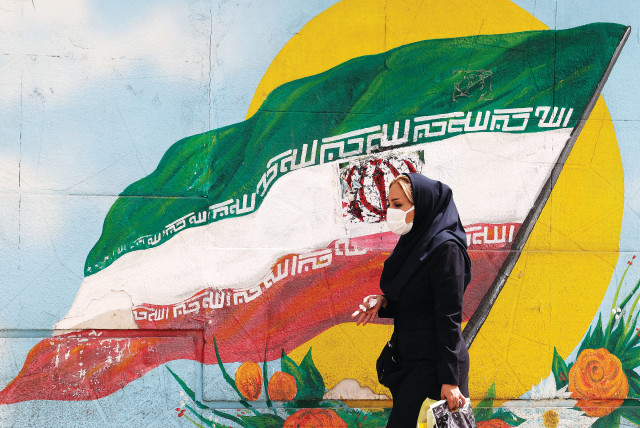Curbing Iran aggression is key to peace in the Middle East - opinion

The Iranian regime acts quietly, patiently, and methodically in regions reigned by instability and chaos.
For over four decades, the leaders of the Islamic Revolution in Iran have been planning the world’s “redemption” by the Islamic Shia. This is the almost unimaginable reality that must be known and acted upon in order to stop it.
Currently, the supreme leader is old and ill, while his less-spoken son, Al-Kshad Al-Shaabi, continues his path with even greater cruelty and fervor.
Tehran has created a magnificent set of proxies through which it works to implement its dark vision. These include “inferior” soldiers in the form of Palestinians in Gaza, Judea and Samaria, and Lebanon- Sunni Arabs.
The Palestinians and/or their national aspirations are of little interest to the Mullahs. The reason for training and financing the Islamic Jihad, Hamas, and similar extremist movements is the promotion of regional chaos, which simplifies taking over as much territory, influence, and resources as possible by Iran.
The Iranian regime acts quietly, patiently, and methodically in regions reigned by instability and chaos. A point in the case is Jabal Druze in Syria. The area has been populated by Syrian Druze for many years. There was a silent understanding between Assad’s regime and the Druze that they would not interfere with his actions and he would not harm them. And so it was for years.

In recent years, however, Shi’ite locals forcefully took over some of the land and properties in that area, spurring intense struggles between local Shi’ites, directed by Iran, and the local Syrian Druze population.
The US removal of Saddam Hussein, the notorious leader of Iraq in the 1990s, created a vacuum into which Iran quickly entered and took control of the Iraqi oil reserves, gaining hundreds of millions of dollars per day. In recent years, when the anti-Shi’ite extremist ISIS emerged, the international arena effectively created a coalition that literally eliminated it, leaving Iran to once more return to being the undisputed force in the region.
In doing so, it unwittingly allowed the Islamic Republic to also continue its production of uranium for the purposes of promoting its nuclear project.
Iran has manufactured a "line" of proxy militias in close proximity to Israel
Iran also created a different “line” of proxies, namely the Hezbollah in Lebanon, the Houthis in Yemen, and the Shi’ite militias in Iraq and Syria. These Shi’ite proxies are seen as considerably more worthy in Iran’s perception, given their loyalty to the Islamic Revolution and its ideology.
In order to create competent Iranian militias imbued with Shi’ite ideology, resources, and soldiers are needed. Iran works to obtain the resources via its revenues from oil sales alongside massive drug smuggling operations throughout the region.
Producing the manpower needed for the militias has been forwarded by a mechanism so insane that it is hard to believe that it is actually real: encouraging Shi’ite girls in various countries in the region to enter into “marriages of pleasure” - a term coined in the Muslim world that grants religious permission to enter into “temporary” marriages, in which it is permissible to have conjugal relations, and after a short time to break up the covenant of “marriage.”
Indeed, Iran had incorporated the subject into the school curriculum for those girls. The children born within the framework of those “marriages of convenience” are then taken by the regime and undergo religious indoctrination to become exactly those aforementioned Shiite militias.
The Palestinian-Israeli conflict is but a convenient excuse for harnessing Arab-Muslim attention, given that the hatred of Israel and the “Zionists” is relatively undisputed in most public circles in the Muslim world. In this manner and by provoking the Hamas attack on Israel on October 7, Iran has thus far succeeded in keeping Saudi Arabia away from normalizing relations with Israel and/or from creating an effective Sunni-Western coalition that will harm its grandiose, imperialistic aspirations.
In the meantime, it continues its efforts to promote its military nuclear program while the US is busy with its internal affairs in an election year, and Israel is preoccupied with returning its hostages held by Hamas terrorists in Gaza and protecting its Southern, Eastern and Northern borders from Iranian-backed extreme Palestinian and other terror organizations.
Jordan, whose regime is weak, trembles under the Iranian weight on its soil. This is the fruit of years-long efforts by Iran, systematic and quiet, as it always is, to gain influence within the Hashemite Kingdom. As I have emphasized more than once in my speeches, briefings, and writings, this is an urgent situation with a very low profile on international media and global public opinion, yet it is most concerning to all stability-seeking Sunni countries in the region, as well as the West and of course, to the State of Israel, given the very long border which Israel shares with Jordan.
The horrific scenario that Tehran is striving for is that the Jordanian government will no longer be able to stop the millions of Palestinians living there from forcefully entering the State of Israel.
The optimal strategic answer to all of the above is the creation of an effective Saudi-led alliance of Sunni countries, which Israel and the Western countries will join in order to make sure that the Iranian threat is curbed.
The writer, a former MK and an expert in Arab affairs is a fellow at the Misgav Institute for National Security & Zionist Strategy in Jerusalem.
